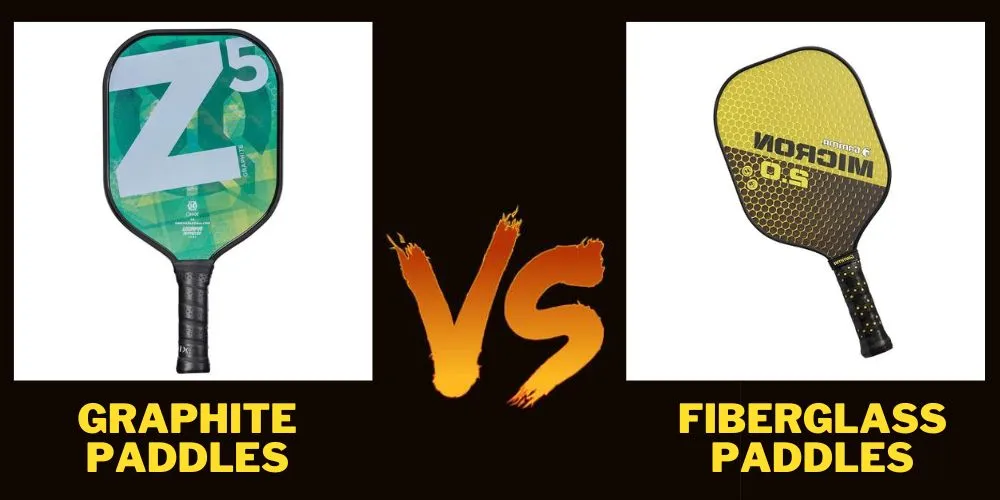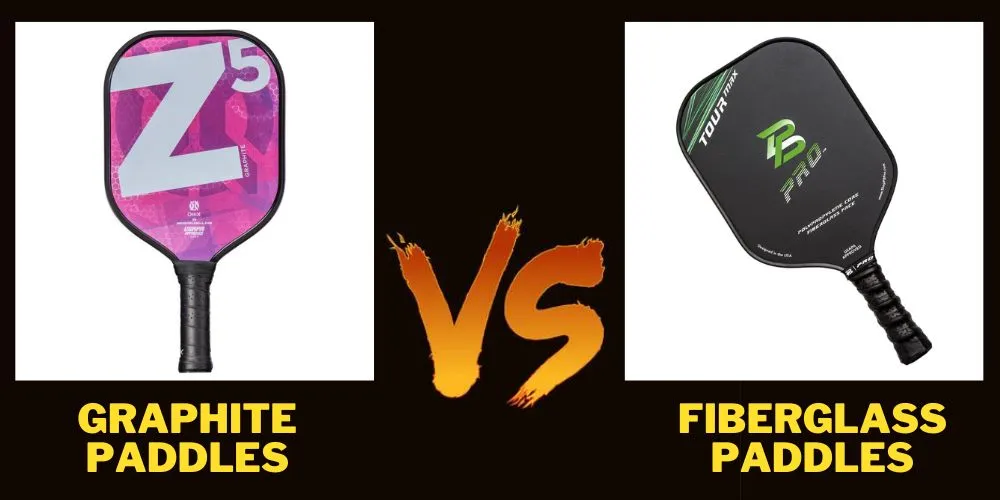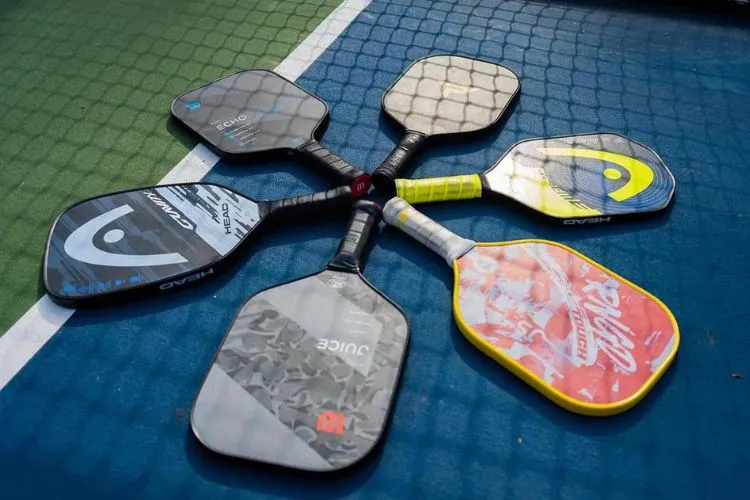Pickleball is a fun and fast-growing sport. It requires speed, skill, and strategy. Selecting the right paddle is crucial for every player, whether you’re a beginner or an experienced competitor.

In this article, we’ll take a close look at two popular materials: Graphite vs Fiberglass pickleball paddles We’ll explore their features, benefits, and drawbacks to help you find the perfect match for your game.
Graphite Pickleball Paddles
Features and Benefits
Graphite paddles are known for their lightness. This feature helps players to move and react quickly. Quick reactions are essential in pickleball, as it’s a fast-paced sport that demands constant adjustments from players. The lightweight nature of graphite paddles also helps reduce fatigue during long matches.
Aside from being lightweight, graphite is strong and stiff. This rigidity allows for better control during play. It ensures a consistent response when the ball strikes the paddle. A consistent response leads to a more predictable ball trajectory.
Drawbacks
Even though graphite paddles have many benefits, they come with a few drawbacks. One of the main concerns is the cost. Graphite paddles are often more expensive than other types. Their price can make them less appealing to some players, especially those on a tight budget.
Another potential drawback of graphite paddles is their durability. The lightweight material may be more susceptible to wear and tear than heavier options. This concern may lead to a shorter lifespan for a graphite paddle compared to other materials like fiberglass.
Fiberglass Pickleball Paddles
Features and Benefits
Fiberglass is another option for pickleball paddle material. It’s a versatile substance that can bend without breaking. This flexibility offers players a unique advantage: spin.
When a ball strikes a flexible surface, it can “grab” temporarily. This interaction lets players put extra spin on the ball, creating challenging shots for opponents.
Another benefit of fiberglass paddles is their affordability. They tend to cost less than their graphite counterparts.
For players with budget constraints, a fiberglass paddle can be a cost-effective choice. Even professional players may opt for fiberglass paddles to save money without sacrificing too much performance.
Drawbacks
While fiberglass paddles have their advantages, they also come with some downsides. One of the primary concerns with fiberglass paddles is their weight.
They are typically heavier than graphite paddles, which may lead to slower movements during games. The added weight can also cause fatigue, particularly during lengthy matches.
Durability is another issue for fiberglass paddles. The material can be susceptible to chipping and cracking, leading to a potentially reduced lifespan.
Additionally, consistent exposure to moisture may weaken the paddle’s structure over time.
Graphite vs Fiberglass Pickleball Paddles: Pros and Cons Explored
In the sport of pickleball, selecting a paddle that complements your gameplay is vital for performance. Two popular choices, graphite and fiberglass, each come with a unique set of pros and cons. Let’s delve deeper into their intricate world.

Graphite Pickleball Paddles
Pros
Graphite paddles have several advantages. Predominantly, their lightweight characteristic contributes to swifter reactions during play. Relatively easier to maneuver, they cater to faster games with less effort, reducing the risk of rapid exhaustion.
Moreover, graphite paddles are known for their strength and rigidity. Their stiff construction results in greater control and accuracy. Each hit is characterized by a consistent response, leading to a predictable trajectory of the ball enabling more confident strokes.
Cons
Despite these benefits, graphite paddles also have certain cons. Of these, cost is a significant consideration.
Because they use high-quality material and a rigid manufacturing process, graphite paddles are more expensive. The higher expense can pose a barrier to new players or to those on a budget.
In terms of durability, there’s mixed opinion among players. While some believe that graphite paddles are durable, others view their lightweight feature as a potential drawback.
The consistent use and stress on lightweight graphite paddles might make them more prone to wear and tear than their heavier counterparts.
Fiberglass Pickleball Paddles
Pros
Fiberglass paddles, on the other hand, come with a unique set of benefits. The flexibility of these paddles is arguably their most significant advantage. This flex allows for a brief “grabbing” of the ball upon impact, thereby facilitating the creation of spin in shots.
Fiberglass paddles are also generally more economical than graphite paddles. Thus, they represent a cost-effective option for players who are starting out or are aren’t willing to invest heavily in kit.
Cons
Despite their reasonable price and the ability to put spin on the ball, fiberglass paddles have a couple of drawbacks. Primary is the issue of weight.
Heavier than graphite paddles, they may negatively impact reaction speed and potentially wear out players more quickly, especially in prolonged matches.
Similar to graphite paddles, fiberglass paddles also face some questions concerning their durability. They are often more prone to chipping and cracking, especially under harsh conditions.
Plus, constant exposure to wet conditions can also lead to problems over time, reducing their effectiveness and potential lifespan.
Each player’s choice between graphite and fiberglass pickleball paddles will boil down to personal preferences, style of play, skill level, and budget.
Both materials have a unique set of pros and cons, and there’s no definitive answer on which paddle type is intrinsically superior to the other.
Thus, the best way to find the perfect match is to assess your needs and try out both paddle types before making a final decision.
Factors to Consider While Choosing a Paddle
When choosing between graphite and fiberglass paddles, several factors must be taken into account. Each player is unique and should consider their individual preferences.
First, consider your skill level. A beginner player may opt for a more affordable option like a fiberglass paddle. It’s crucial not to overspend on equipment when first learning the sport. On the other hand, advanced players might appreciate the improved control that comes with a graphite paddle.

Budget is another essential factor. If you’re working with a limited budget, a fiberglass paddle will likely be a better choice. If the price is less of a concern for you, don’t hesitate to explore both graphite and fiberglass options.
Play style should also be taken into account. Players who prefer quick reactions and excellent control may lean toward a graphite paddle. In contrast, those who want more flexibility, spin, and challenge for opponents might prefer a fiberglass paddle.
Lastly, personal preferences play a critical role in choosing the right paddle. No two players are alike, and what works for one may not work for the other. Whenever possible, try out different paddles to see which material suits you the best.
Other Comparisons You May Also Find Useful: 13mm vs 16mm Pickleball Paddle | Graphite vs Composite Pickleball Paddles
Conclusion:
Both graphite and fiberglass pickleball paddles offer unique benefits. Graphite paddles provide better control and faster reaction times due to their lightweight structure.
On the other hand, fiberglass paddles provide extra spin and flexibility at an affordable price.
To determine which option is right for you, take into consideration your skill level, budget, play style, and personal preferences.
Ultimately, the paddle you choose should be the one that feels the most comfortable and enhances your game. Testing multiple paddles is the best way to make an informed decision.

Pickleball’s more than a game to me—it’s a passion. I write, sharing its highs and lows, the thrills and the lessons. Some tales might draw you to the court, while others give a hint of the game’s magic. So, curious about my journey? Ready to dive deep into the world of pickleball with me? Let’s go.
